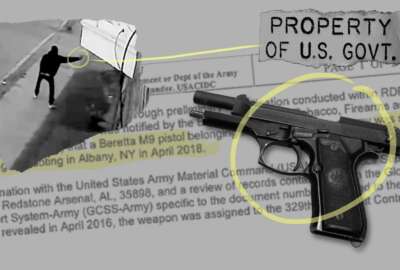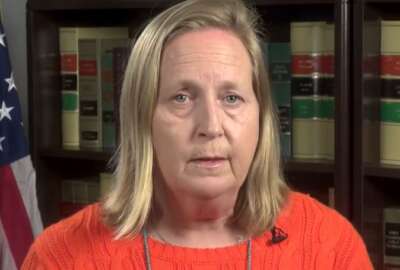Hubbard Radio Washington DC, LLC. All rights reserved. This website is not intended for users located within the European Economic Area.
DoJ launches new effort to keep guns from dangerous hands
A new Justice Department resource center will help jurisdictions carry out firearms laws to keep guns from people deemed a danger to themselves and others.
Federal and state firearms laws keep guns from people deemed a danger to themselves or others. At least that’s the theory. Now the Justice Department has formed what it calls a resource center to help jurisdictions carry out these laws. It’s called the National Extreme Risk Protection Order Resource Center. For how it works, the Federal Drive with Tom Temin spoke with the Director of the Bureau of Justice Assistance, Karhlton Moore.
Interview Transcript:
Tom Temin Is the issue that we’re concerned with here the fact that even though, yes, guns are not supposed to be in the hands of people that are deemed a danger in a practical sense, that’s a pretty hard thing to enforce, isn’t it?
Karhlton Moore Yeah, it’s certainly challenging for local communities. And really, the resource center is all about providing tools to jurisdiction, to have laws on the books, to be able to meet that challenge that you so aptly described.
Tom Temin Just briefly, we should probably help define what an extreme risk protection order is. This is something that would typically come from a court.
Karhlton Moore Yes, and it can vary by jurisdiction. But the order will come from the court. And when I say vary by jurisdiction, that is around who can make the request for an extreme risk protection order. But yeah, the order comes from the court. It’s really focused on the state that a person is in, in the moment, and that there is a belief that they are a danger to themselves or to others. And so, you can go to the court, and you can ask for this. There are some protections that are provided to a person who may find themselves the subject of an extreme risk protection order, and then the court makes an order and it can last for, you know, a certain amount of time before a person may have their rights restored, which is an important aspect of this work as well.
Tom Temin And maybe just give us an example of the type of information that could help a local jurisdiction obtain the weapon, say, and carry out an order such that everybody is treated the way they should be, as you mentioned.
Karhlton Moore You mean in terms of the things that could cause someone to want to report, maybe a family member or something like that as being a danger to themselves or to others?
Tom Temin Well, I meant if a NERPO, you know, is out on someone, what does a typical procedure look like? So that the person who is to be protected from gives up whatever it is they have to give up their weapon. But yet that person has rights also under the law.
Karhlton Moore Right. They do. And they have protections that the local jurisdiction in the state is really required to follow. And some of those things are identified actually in the law in terms of when a hearing has to take place, they have the opportunity to be heard. You certainly have to have a process in place for them to be able to, once they are deemed to no longer be a threat to themselves or to others an opportunity to get their rights restored. So those are some of the protections that exist, and those are protections that, jurisdictions who do this, who decide that they’re going to implement ERPOs with resources from BJA. I want to make that very clear. There are jurisdictions around the country who are not receiving resources from BJA, but our resources. There are very specific things that people have to follow in order to get those. And as a matter of fact, we require in order to utilize our resources, we require a jurisdiction to do an analysis of their practices, and they have to certify to us that those protections are in place. And that’s an important part of this work as well.
Tom Temin We’re speaking with Kharlton Moore, director of the Justice Department’s Bureau of Justice Assistance. Well, what form does this technical assistance and training take? Do people come to a physical place and hear from their peers and hear from justice practitioners? Is it online or published documents?
Karhlton Moore Yeah. So, it can take a lot of different forms. So, we just talked about peer-to-peer support. So that is really sending criminal justice professionals from one jurisdiction, and they go to another jurisdiction. So that is certainly on site where they would learn from their peers in a different jurisdiction. There’s the opportunity to utilize webinars and trainings where you can hear from experts who have experience in extreme risk protection orders. So, there’s certainly training that we can do through webinars. There’s the production of documents that people can look at as they try to develop policies around the practice of extreme risk protection orders. So, it will take on multiple forms in terms of deciding what’s the most appropriate and the best way for people to learn how to implement this in the right way. And that’s another thing that I really want to stress. Fidelity is important. It doesn’t really matter if we’re talking about extreme risk protection orders, or if we’re talking about how to implement focused deterrence, or if we’re talking about how to implement a problem-solving court. The way it’s implemented makes a big, big difference. There’s an entire science around implementation, implementation science. And sometimes implementation can go so wrong that people never get to see the benefit of the investment of both resources and time that they’re making. And so, one important role of the resource center is to be quality control, and to make sure that things are being implemented in the right way.
Tom Temin And maybe just give us a sense of the volume of activity around NERPOs that comes in through the Justice Department annually. Are we talking about tens of thousands of these things? Thousands or what?
Karhlton Moore Well, the NERPOs don’t come to us. I mean, this is a local.
Tom Temin No, I just meant how much are you called upon for, you know, the NERPO activities?
Karhlton Moore Well, yeah, we just set up the resource center just a couple months ago. It went live just a couple of months ago. And so, we are early into our endeavor, into the resource center and supporting this work. But certainly, there has been support for this work that has gone on for many, many years. And as you know, a lot of this was developed around protections associated with domestic violence protection orders. It does have a rich history, but we as a department are early into our investment.
Tom Temin Any signs of interest so far?
Karhlton Moore Oh, yes. Definitely. We have made. Let me just take a little step back and just talk about the process that exists. So, for those states who have an existing ERPO law, and I want to stress that this is for states who have existing laws. Okay. Our training and our technical assistance are on site peer to peer work. Those things are focused on that. As a matter of fact, in order to access resources to fund any type of work around ERPOs. The first thing you have to do is a state has to form a board. So, they must form a board that is going to help develop their plan. As a matter of fact, you can’t get a single dime for implementation from BJA until the state has developed a plan. We do allow states to get an initial drawdown of $20,000 to help them through the planning stage. So, once they have access to those resources, they develop that board, then the board, the state crisis intervention board, they develop a state plan. And I really want to stress this is state focused. States develop plans. What a state decides to do is the decision that that state is making. I don’t have the ability to make a state engage in a practice that they don’t want to engage in, and I wouldn’t want to be able to do that. But once the state develops their plan, they submit their plan to us. We make sure that the certification is done, that it fits with the guidelines associated with this particular funding and a whole host of other grant things that probably most of your listeners don’t have any interest in. And then we approve their plan, right. And sometimes it’s a back and forth to make sure that everyone’s on the same page. And then the state goes to work in implementing their plan for people who decide that they want to do ERPOs, the ERPO has to be in their plan. So, you can’t surprise us and say, oh, we never talked about this, but we want you to fund our ERPO work that ERPO work has to be in there. They have to have that certification. And then the state goes about the business of implementation and hopefully saving lives.
Copyright © 2024 Federal News Network. All rights reserved. This website is not intended for users located within the European Economic Area.
Tom Temin
Tom Temin is host of the Federal Drive and has been providing insight on federal technology and management issues for more than 30 years.
Follow @tteminWFED





